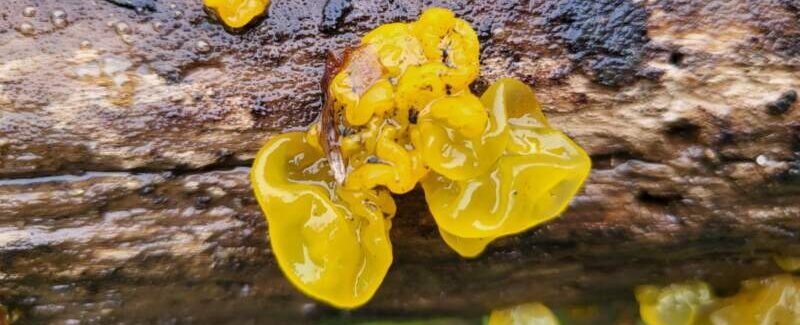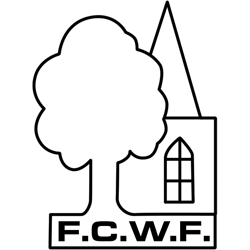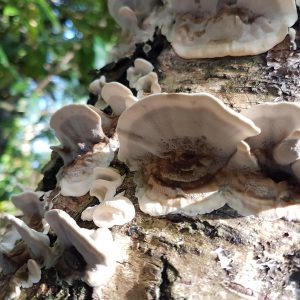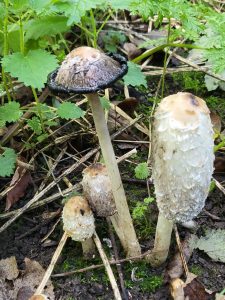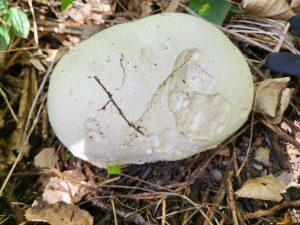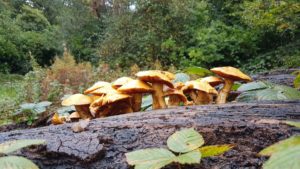
Biologists have identified over 100,000 different types of fungus, and depending on the season, many can be found in Childwall Woods and Fields.
Fungi are a separate kingdom of living things and are not related to animals and plants, although they may appear to be plant-like.
They reproduce by releasing spores and they present themselves in a variety of beautiful shapes, sizes and colours
All fungi feed on organic material, and below you will be able to see the different ways they get their nutrients. Here are some of the different species of fungi found in Childwall Woods and Fields grouped according to their preferred food and habitat.
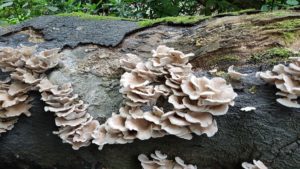
Fungi that live on wood – Saprotrophs, the Recyclers
Saprotrophic fungi break down wood and recycle its nutrients back into the soil after extracting what they require as food. Some of them consume the cellulose in the wood and some target the lignin. These are the compounds that make wood hard. Without them the wood crumbles.
There are many types of Saprotrophic fungi and you will see them throughout Childwall Woods growing out of healthy-looking trees, their tiny fungal threads (mycelium and hyphae) spreading through the heartwood, causing it to rot.
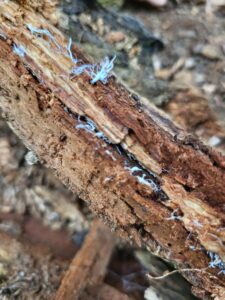
The large brackets on the trunks of trees are the fruiting bodies of the fungus and they tell us that the cellulose and the lignin in the heartwood are being consumed and the tree will start to become too fragile to remain standing. The softened wood will eventually fall and is recycled back into the soil.
The saprotrophic fungi that take their nutrients from living and dead wood, last for years, and are visible throughout Childwall Woods as Brackets or Polypores.
Bracket Fungi – Saprotrophic Polypores
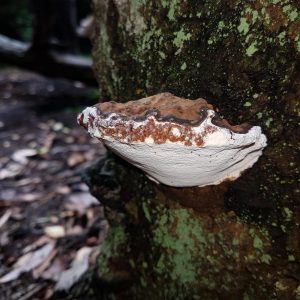
Polypores are a group of fungi that have pores (tubes) tightly packed on the underside to disperse their spores. They come in all shapes and sizes and some live for years. They may look quite different from each other but they are all breaking down the wood by secreting enzymes into it to dissolve compounds that they consume.
Below are the different kinds of polypores that can be found in our woods and you will certainly be familiar with some of them.
Turkey Tail, Trametes versicolor
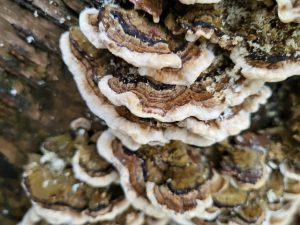
Turkey Tail, Trametes versicolor.
This small polypore is seen all over our woods wherever there is rotting wood. Easily identified by its bands of colours fanning out like a turkey’s tail, always having a white band on the edge. The spores are very small and close together on Trametes versicolor
Turkey tail is a highly prized medicinal mushroom used in Japan and China in herbal remedies for hundreds of years, but more recently has been approved for use as an adjuvant treatment for gastric cancer in those countries after extensive clinical studies. ( Science Direct 2020)
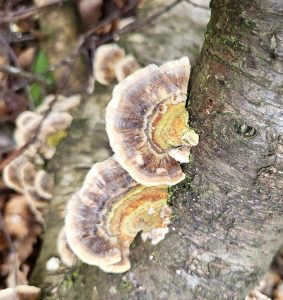
These are last year’s Turkey Tails with a band of new growth this year.
The green tint is a slight growth of algae from over the winter.
Ganoderma Brackets
Ganoderma brackets are known for their large firm cap which grows on living and dead trees but depending on their species they will have different characteristics. These too are saprobic, weakening the tree from the inside where the mycelium (fungal fibres) is breaking down the heartwood. The brackets are the fruiting body of the mycelium.
Southern Bracket, Ganoderma Australe
This southern bracket is still young and compact but will become wider and more distinctively shelf-like as it ages.
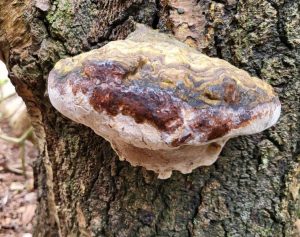
Ganoderma australe
The Ganoderma fungus is a white-rot fungus that slowly breaks down the lignin in the wood until the tree is dead and then acts as a decomposer, returning all nutrients to the soil.
Artist polypore. Ganoderma applanatum.
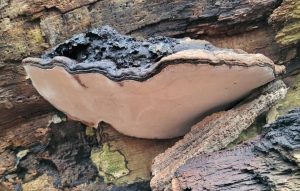
The genus Ganoderma is a family of brackets that can be seen all around our woods in various stages, and as they last for years they can be seen growing larger each year. Years ago it was used by artists as the underside is a good medium for etchings which are preserved by drying.
This is a bracket that emerged on an old fallen log, showing the untouched underside.
This family of brackets likes to grow horizontally to give their spores the best chance of dropping unobstructed. This is known as geotropism, where the organism orientates itself according to the pull of gravity.
You might wonder what would happen if the tree falls and the bracket finds itself in a different position.
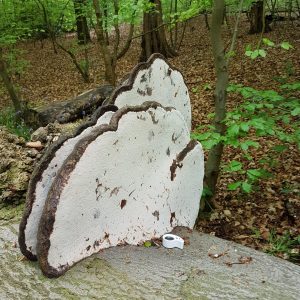
This is an example of a large bracket in the Black Woods being thrown on its back when the tree was cut for safety reasons.
This is the image of the same bracket after 2 years of new growth.
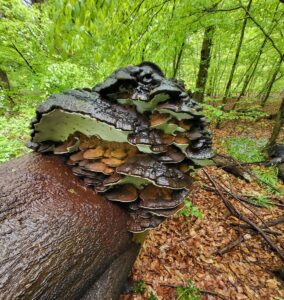
It responded to the new orientation by producing new brackets horizontally—a perfect example of geotropism.
The spores of the Ganoderma brackets are like powdered chocolate.
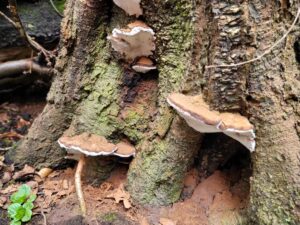
The Birch Polypore, Fomitopsis betulina
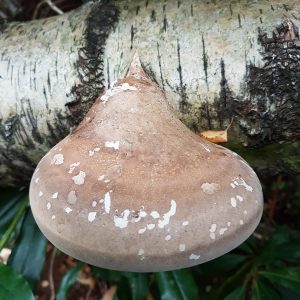
This bracket fungus is only found on dead or dying Birch trees which it feeds off and is often the cause of their demise as this fungus is also pathogenic. It is unmistakable due to its smooth bulbous appearance when young. The birch polypore has been used in natural remedies for centuries and is known for its many medicinal properties.
The birch tree it is growing out of has fallen over but the fungus still grows horizontally.
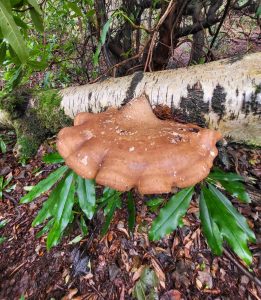
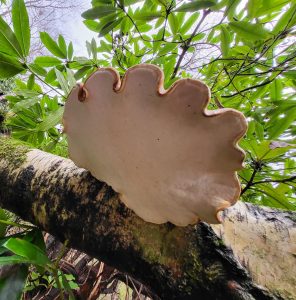
This is the same polypore in November when fully developed and nearing the end of its life.
Its underside beautifully rippled around the edge. You can see the white pores, closely packed. This is where the spores are grown deep inside the tiny pores, and then dropped to be dispersed by the wind.
Beefsteak Polypore, Fistulina hepatica
This is another species of polypore that you might occasionally see in the woods.
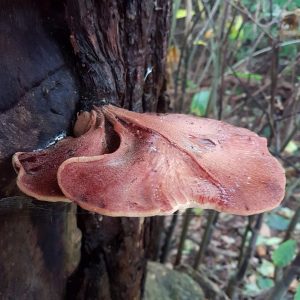
Beefsteak Polypore
This stunning fungus favours sweet chestnut trees and oaks, where it lives inside the trunk of some of our veterans weakening the heartwood by causing it to rot. Invisible until the tree is cut then the red staining of the mycelium can be seen in the wood, making it highly desirable to woodturners.
The spores of the Beefsteak Polypore may have found their way into the heartwood of the tree many years ago but were kept in check by the tree’s defences. Then as the tree ages and its defense system weakens, the mycelium moves through the wood and eventually produces fruiting bodies to reproduce.
Last year, low rainfall caused our trees to show signs of stress and this fungus was able to erupt on three of the sweet chestnut trees.
The large tongue emerges slowly from the tree over 2 weeks starting as a small group of red bubbles in the autumn and growing out further each day until this wonderful shape is reached. Keep a look out for it and let me know if it appears. You may need binoculars as it’s sometimes high and only occurs every 2 years in our woods.
Chicken of the Woods, Laetiporus sulphureus
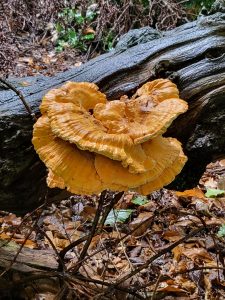
Chicken of the woods is a bracket fungus sometimes called Sulphur polypore, but unlike most brackets, it is soft and edible. This clump grew on a fallen branch of a sweet chestnut tree, breaking down the wood and returning the nutrients to the soil when it had had its fill.
It is often seen on living wood giving us a clue that the heartwood is being digested by this organism.
Lacquered Bracket Ganoderma lucidium (rare)
A recent find on a rotting tree stump was Lacquered Brackets, seven of them.
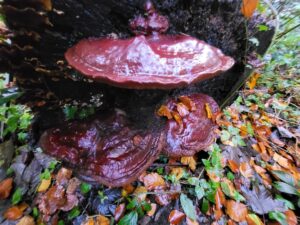
Never seen in Childwall Woods until August 2023 when a cluster of these polypores appeared on a rotting tree stump. Breaking the wood down by extracting the lignin and cellulose, and recycling the nutrients left behind.
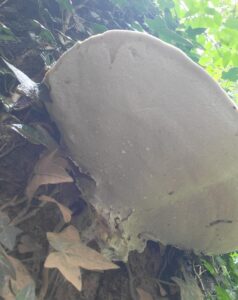
White, tightly packed pores can be seen on the underside of the polypore but not a stipe (stalk) which is often present with this fungus.
This is a rare fungus in the UK and there are only a handful of verified finds registered.
Lumpy bracket, Trametese gibbosa
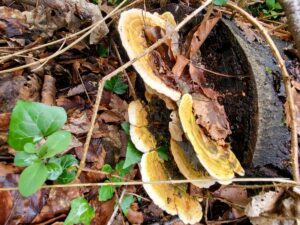
A hardy polypore that lives through the winter, gathering moss and leaves. It lives off the dead wood and tree stumps that are left to rot in the woods and is often found in damp leafy areas.
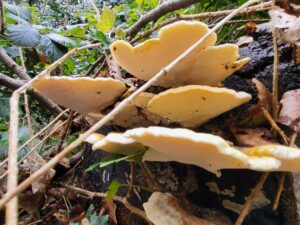
The undersides of the brackets, where the spores are released, are remarkably clean and white.
Unlike the Lacquered Bracket, the Lumpy Bracket is common throughout the country.
Smoky Brackets, Bjerkandera adusta
These pretty little brackets might be mistaken for Turkey Tail mushrooms (Trametese versicolor) from the top but a glance underneath will show its true colours. This smoky bracket is a white rot pathogen able to kill live trees but found most often on dead ones. The grey shading underneath is a clue to its darker side.
However, this little bracket has properties that are very good at breaking down synthetic textile dyes and is under research for possible use in bioremediation.
Hairy Curtain Crust, Stereum hirsutum
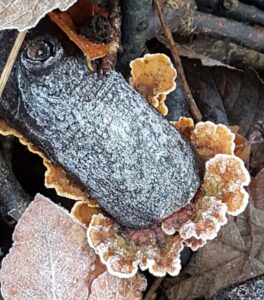
Hairy Curtain Crust is on dead wood everywhere. It is always one of the first species to appear on fallen logs and stumps and is known as a ‘pioneer wood-rot species’. The enzyme it secretes into the wood to dissolve the lignin acts as a kind of bleach which lightens the wood, making this a white rot fungi. As soon as all of the lignin is removed Hairy Curtain crust will die, but not until it has released its spores from its underside.
Dryad’s Saddle, Cerioporus squamosus
Also known as scaly polypore the dryad’s saddle fungus is often seen on dead wood and stumps in the Northern Ornamental woods.
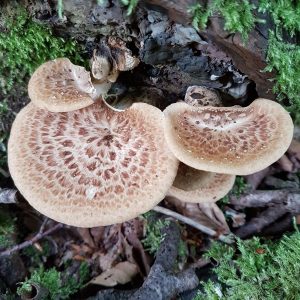
Dryads saddle
A white rot bracket. Found on dead and living trees where it attacks the heartwood. Quite a regular visitor to the woodpiles in our woods but not very hardy and is quick to disappear.
Saprotrophic Fungi with Gills
Oyster Mushrooms, Pleurotus Ostreatus
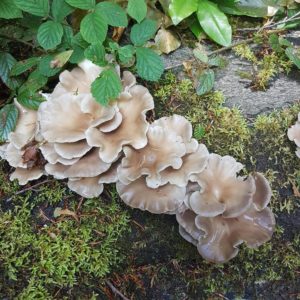
The oyster mushrooms are one of the first species to spread across a fallen branch or felled tree trunk. Their oyster-shaped fan can be fluted as seen here. Not only are these beautiful mushrooms choice edible mushrooms but they are medicinal too and have antiviral properties.
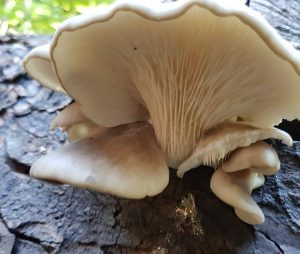
Gills release the spores not pores.
The oyster mushroom is often used commercially in mycoremediation as it is very good at removing toxic substances from polluted land and is very good at breaking down substances in the trees and returning them to the land. HOWEVER, Oyster mushrooms are also carnivorous and feed on nematode worms in the dead wood.
Silky Rosegill, Volvariella bombycina
A rare mushroom, but seen in Childwall Woods and Fields on two occasions.
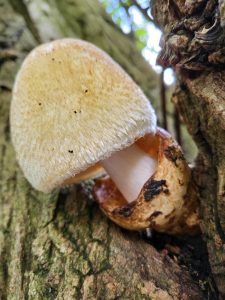
This uncommon mushroom was first noticed emerging from its thin egglike sac. Growing in the branches of a Poplar tree where its mycelium inside the tree was living off the nutrients in the wood.
It emerged rapidly over the next few days, the stem growing quickly until a beautiful cap covered in silky hairs is seen. The gills began as white but quickly matured to rosy pink which is how it gets its name.
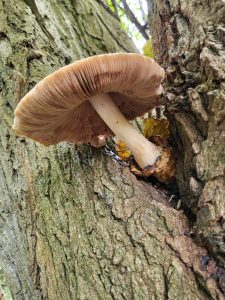
Medicinally, this mushroom has antibacterial properties.
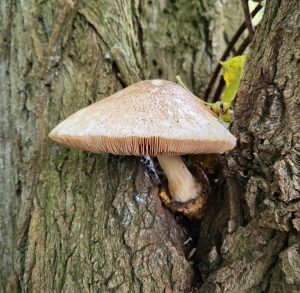
Finally, after releasing its spores, it melted back into the tree where it came from, helped a little by the tree slugs who found it to be a tasty meal.
Glistening Inkcaps Coprinellus micaceus
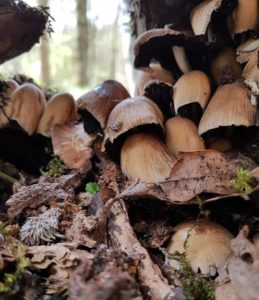
Although tiny these beautifully delicate inkcaps have a presence in the woods by appearing in dense clusters at the base of trees. They are tiny saprobes, feeding on the wood and as they become mature will deliquesce (turn to ink), dripping their spores into the ground.
Sheathed Woodtuft, Kuehneromyces mutabilisr
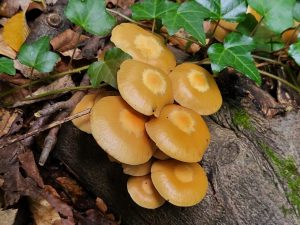
Clumps of the Sheathed Woodtuft are a common sight in woods where there are old trees and it particularly likes the stumps of beech, birch and alder, which it breaks down while taking the nutrients it needs.
The caps change colour as they take in water from around them which accounts for the lighter dry patch at the centre of the cap.
A pleasing sight to come across in the damper parts of the woods.
Sulphur Tufts, Hypholoma fasciculare
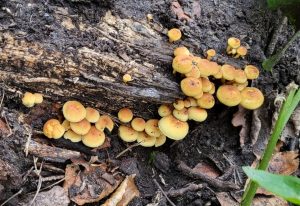
A common sight in spring when temperatures are still low and not many other mushrooms are about. They are a saprobic species, growing in clumps on rotting wood. To be sure it is Sulphur tuft, just look for its slightly green gills.
Spectacular Rustgill, Gymnopilus junonius
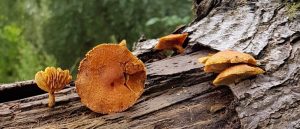
The Spectacular Rustgill is so-called as it can grow to a spectacular 30cm across. These were much smaller however but spectacular in their colour and form. These mushrooms have a slightly scaly surface and are growing out of the old fallen tree on the top field breaking it down. This is a very wet area and perfect for this type of mushroom.
Velvet Shank, Flammulina velutipes
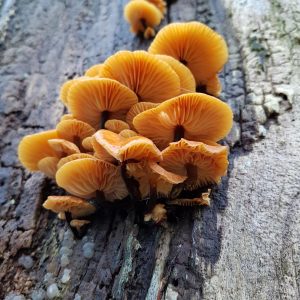
Velvet shank grows in colonies on old, compromised trees, in winter. Its cap is a dark orange but its velvety stipe (stalk) turns dark brown as it matures.
These were high on a large beech tree where the mycelium inside the tree was extracting the nutrients it needed to produce these fruiting bodies.
Split Gill, (Schizophyllum commune)
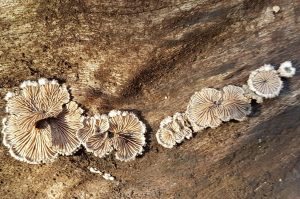
A tiny fuzzy bracket that emerges after rains in the warmer months.
Here it is growing as rosettes but is more usually seen as fuzzy little brackets.
It is a saprobic fungus breaking down the lignin in the wood.
This tiny mushroom is prized in many countries for its medicinal properties and is being researched for its immunomodulatory, antifungal, antineoplastic and antiviral properties.
A very unusual but beautiful little fungus.
Common Bonnets, Mycena galericulata
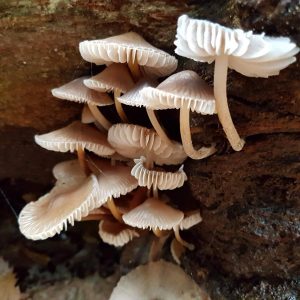
Bonnets can be seen all over the woods covering fallen branches and logs, especially where the bark has fallen off and its mycelium can penetrate the wood. It is a saprobic mushroom living off dead and dying wood, breaking it down so that the nutrients it doesn’t want are returned to the soil.
These beautiful mature specimens were growing from a very old sweet chestnut branch on the ground by one of our veteran trees.
Shaggy Scaleycaps, Pholiota squarrosa
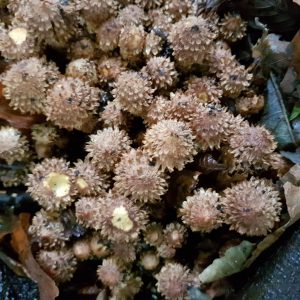
These little show stoppers come in large groups and can often be found in Childwall Woods in the roots of Beech trees. They are only seen on old trees as they are saprobic and mildly parasitic and are quietly taking their nutrients from the heartwood of the tree.
The little conical caps flatten out with age to drop their spores.
Porcelain Mushroom Oudemansiella mucida
The little wet fellow below, the Porcelain Mushroom, is another wood rot mushroom that prefers beech wood and you may have taken the weight off your feet on the log by the main path where this was discretely growing.
It is saprobic (wood-consuming) and slightly parasitic.
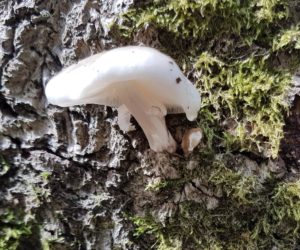
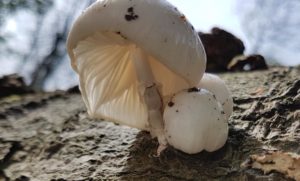
This delicate mushroom has a coat of mucus making it look wet. The Porcelain Mushroom like all fungi has a secret weapon to keep it healthy while it produces spores and this one has an effective fungicide to protect it from other fungi who might want to consume it.
Saprotrophic Jelly Fungi
Purple Jellydiscs, Ascocoryne sarcoides
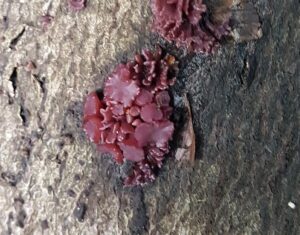
A fungus often seen in the woods on dead trees and is the fruiting body of the mycelium living inside the wood.
Studies have shown that A. sarcoides wards off other pathogenic fungi and can live inside the tree causing no harm until the tree ages and begins to die then it will begin to break down the wood to return the nutrients to the soil. Perfect recycling.
Trembling Merulius, Phlebia tremellosa.
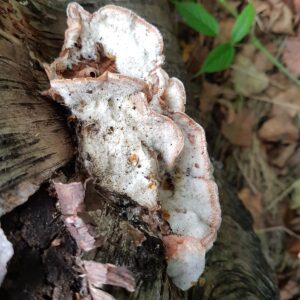
A pink furry outcrop with a jelly-like texture. Its underside is white when young but turns dark with age. There is no stem but has visible pores. You would be forgiven for thinking this was some leathery bracket but it is considered to be a crust fungus and is often called ‘Jelly rot’
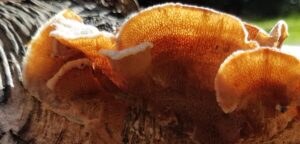
Trembling Merulius, underside on a sunny day.
It is a decomposer, feeding on the lignin in the wood and will only grow on dead logs and stumps of deciduous trees.
Wood Ears, Auricularia auricula-judae
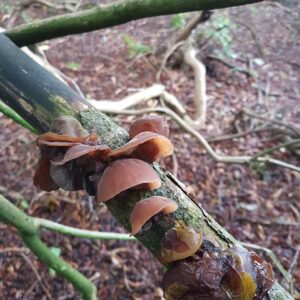
Wood Ears, Auricularia auricula-judae can be found on old dying branches in the woods. An edible fungus and an eastern delicacy these jelly fungi are quite easily recognised. Prized for their use in soups in Chinese cuisine.
Black Bulgar. Bulgaria inquinans
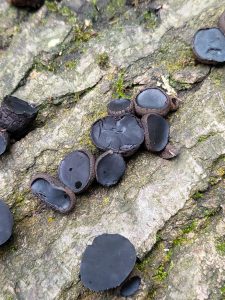
Growing in large clusters on felled or fallen oak, this saprobic fungus consumes the rotting wood of the fallen tree producing these small black jelly-like discs to spread its spores. When young they appear as flat discs but as they age they become cups showing the rough scaly outer parts.
Crystal Brain, (Myxarium nucleatum)
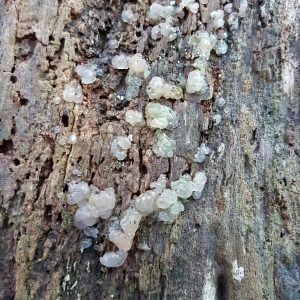
Crystal Brain is a jelly fungus associated with rotting wood (saprobic). It particularly likes our very old beech trees and the very wet weather helps it to display its gelatinous fruiting bodies that can coalesce into one brain-like structure.
Other Saprobic Fungi Living off Wood
Birch Woodwart, Jackrogersella multiformis
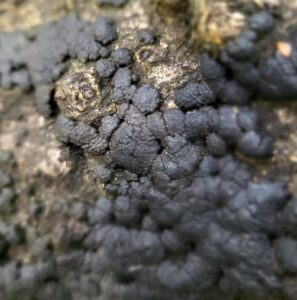
Not the prettiest of fungi but an essential part of any woodland, breaking down and decomposing the fallen dead wood, returning the nutrients to the soil for other plants to use after it has taken what it wants.
This particular warty fungus prefers rotting birch wood.
Purple Oak Crust, Peneophora quercina
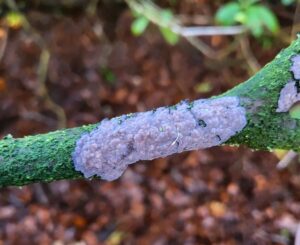
A waxy lilac wood decay crust that prefers fallen branches of oak like this one but has been seen on beech.
It is known to be a ‘pioneer species’ meaning it is one of the first fungi to appear and begin to break down the wood.
Dead Man’s Fingers, Xylaria polymorpha
You would be forgiven for thinking that there was a body under this rotting log, but these fingers are the fruiting bodies of Xylaria polymorpha, a saprobic fungi breaking down the dead wood.
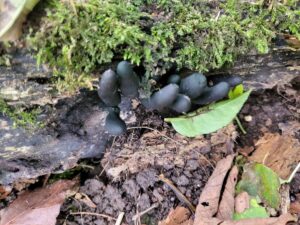
As its name suggests (Polymorpha) this can appear in many forms but mostly like little black or grey fingers which grow spores on the outside. A process that can take months.
To find this fungus look around the base of old tree stumps or on the underside of old rotting logs, like this one.
Dead Moll’s fingers, Xylaria Longipes
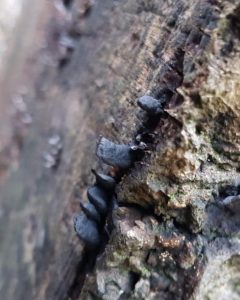
These tiny black protrusions are a species of fungus and were growing from under the bark on the old felled tree near the main gate to the woods. Slimmer than ‘Dead Mans Fingers’ which were spotted last year. This fungus is found mostly on fallen deciduous trees.
Small Staghorn, Calocera cornea.
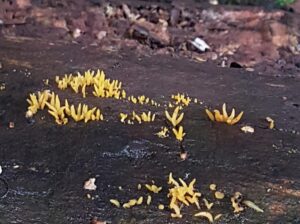
A very wet, felled beech tree is the perfect place to see Small Staghorn, (Calocera cornea).
These tiny yellow fruiting bodies push out of wet deciduous tree trunks in small waxy bunches. Its Latin name meaning beautiful waxy horns is a perfect description of this tiny wood rot fungus. It likes damp shady places and can be seen all year round but mostly in autumn.
Candlesnuff Fungus, Xylaria Hypoxilon
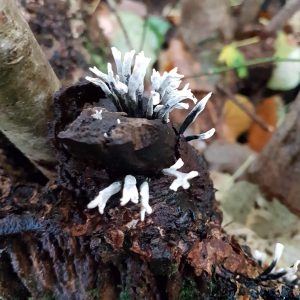
A tiny erect fruiting body, dark at the base but powdery at the forked tip.
This fungus derives its nutrients from damp rotting wood, so it prefers the dark damp places of our woods.
This is a bioluminescent fungus and emits a tiny amount of green light caused by phosphorus within it reacting to oxygen in the air.
Saprobic Fungi that live off Wood Debris in the soil.
Common Stinkhorn, Phallus impudicus
The Common Stinkhorn is a master of timing. It prepares its fruiting bodies as small round eggs and they wait in readiness for conditions to be perfect for them to hatch.
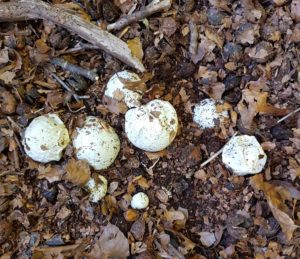
In spring you may see a cluster of stinkhorn eggs if you poke around in the leaf litter.
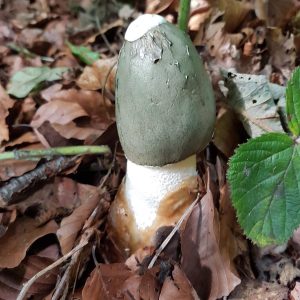
When the weather is perfect and flies are around, the stinkhorn emerges from the egg. The perfect young specimen shown above has only just emerged from its pinkish egg in the ground, still visible at its base.
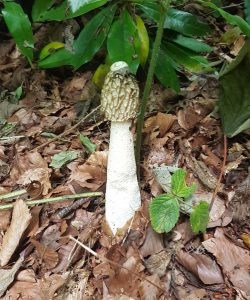
Within a day it will have grown to 30 cm high and a sweet rancid smell will fill the air from the dark sticky cap. The smell is sweet and mimics rotting flesh which will attract flies that devour the dark goo. That contains the spores which stick to the flies and are carried away to new ground. Once the spores have all gone, the stinkhorn collapses.
The Phallus impudicus mycelium underground feeds on wood debris that falls from trees or on rotting roots. Its main function is as a decomposer breaking up dead wood and taking the nutrients it requires to expand and spread.
If you notice a sweet smell in the woods, look down.
Scarlet Elf Cup, Genus Sarcoscypha
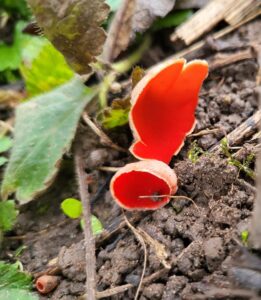
This bright red cup fungus has been seen in many countries in the Northern Hemisphere but not very often. A scarce species, growing on rotting sticks and branches in damp soil, the woody ground of the middle field is the perfect habitat for this fungus, where this specimen was seen.
Oysterlings, Crepidotus variabilis
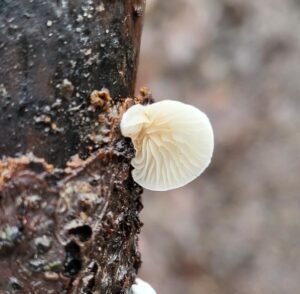
A beautiful little fungus that grows on dead twigs of broad-leaved trees such as beech, and can often be seen on the floor of our beech wood. The shape is variable and they darken to pink with age, but is always a pleasure to come across.
The Common Puffball, Lycoperdon perlatum
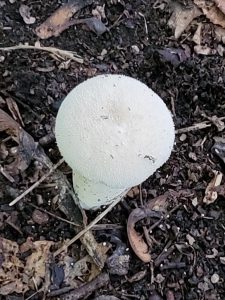
Often called the Gem studded puffball because of the spikey gems on its cap. Like all puffballs, when it is mature a hole opens on top of the cap and dustlike spores emerge as puffs as the sides are compressed. It likes the grassy parts of our woods near trees where it consumes wood debris in the soil.
Stump Puffball, Lycoperdon pyriforme
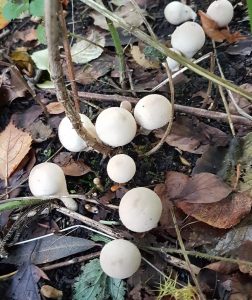
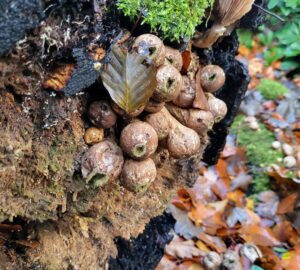
Stump Puffball, is another wood rot fungus and is different from the Common Puffball as it grows on tree stumps and dead wood, and is pear-shaped. They may look as if they are growing out of the ground but there will be a dead branch or dead roots buried underneath them.
Puffballs develop a pore (hole) in the top where the spores are ejected. Puffballs can release seven trillion spores each with only one or two becoming new puffballs.
Clouded Funnel, Clitocybe Nebularis
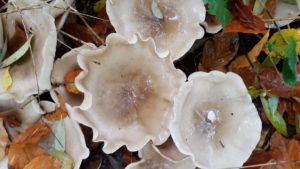
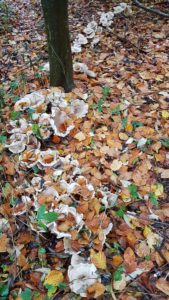
Photo by D Holland
One of many funnel mushrooms that can be seen in the woods. This fungus prefers broadleaf litter which it breaks down for nutrients.
Here a colony can be seen growing in a line under deciduous trees on the top field. Usually, it can be seen forming large circles.
Saprotrophic Fungi that do not live off Wood.
Shaggy Inkcaps, Coprinus comatus
Also known as judges wig mushrooms due to their shaggy curls, these inkcaps like all of this genus, will very quickly roll back their caps and deliquesce (turn to liquid), dripping their spores back into the ground in their black ink. They are saprobes and live off decaying plants and animals in the soil.
Giant Puffball, Calvatia gigantea
This Giant Puffball was found under the Poplar trees, on the top field in early October.
The size of a football and brilliant white but If left to mature the inside slowly turns to brown spores and eventually, they blow away in the wind.
Commonly found in woodland in autumn this pure white fungus was cut into strips and used as dressings for soldiers in battle years ago due to its high absorbency, and it is also known for its anti-tumour properties.
Parasitic/Pathogenic Fungi – The Destroyers
Giant Polypore, Meripilus giganteus
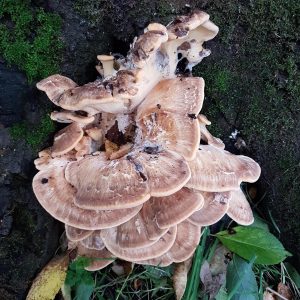 This fungus consumes the lignin in wood causing a ‘white rot’ which is not a problem on this tree stump but is part of the decomposing process performed by fungi, however, it also attacks the roots of healthy trees causing their demise.
This fungus consumes the lignin in wood causing a ‘white rot’ which is not a problem on this tree stump but is part of the decomposing process performed by fungi, however, it also attacks the roots of healthy trees causing their demise.
The Thin Walled Maze Polypore, Daedaleopsis confragosa.
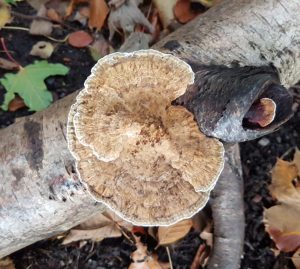
This polypore forming on a fallen willow tree insists on growing horizontally. If the tree were standing it would grow out horizontally as a bracket. It is a wood pathogen causing the demise of the tree it will live off.
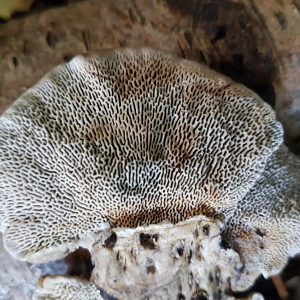
The hidden maze where the spores are released.
The beauty of this polypore is its underneath which is where you can find the Maze.
Honey Fungus, Armillaria mellea
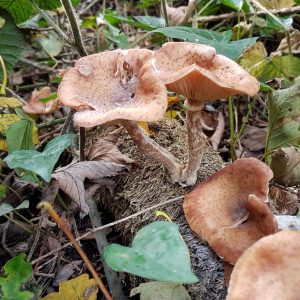
Honey fungus.
This is a pathogenic fungus which causes rot in a weakened tree and will eventually bring it down.
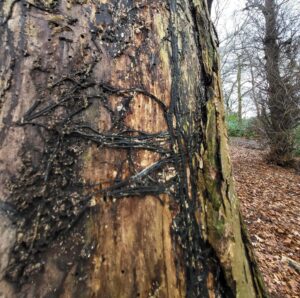
Bootlace Rhizomes of the Honey Fungus
There are 30 species of honey fungus which look very similar and all attack the roots of living trees. You will see the strands of fungal fibres (rhizomes) covering the tree between the wood and the bark, separating the two as the fungus takes over the tree removing the nutrients it requires, eventually killing the tree. You will see a few dead trees in Childwall Woods with black bootlace rhizomes wrapped around them. Few are still standing.
Brittle Cinder Kretzschmaria deusta
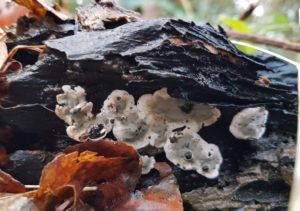
Don’t be fooled by this small grey fungus. Although it looks innocuous it is quite deadly to the tree that it infests.
A pathogenic species, it can be seen throughout the woods on dead stumps or trees weakened by age. Taking out the cellulose and lignin from its host, this fungus slowly spreads around the base of the tree, turning black and brittle and softening the wood until it cannot support the weight of the tree and the tree falls over.
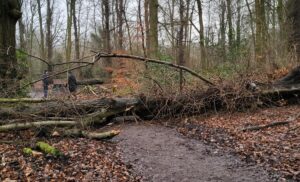
Weakened by Kretzschmaria deusta, this tree was blown over in December 2023
Coral Spot, Nectria cinnabarina
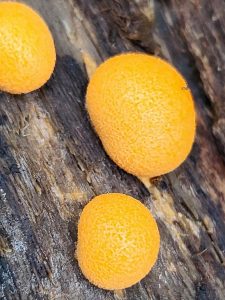
Coral Spot is a plant pathogen that enters the tree through a wound or hole in the bark and is mildly parasitic on living trees. On dead trees, it acts as a decomposer and it is often seen in Childwall Woods on dead branches still on the tree or sometimes on the ground.
Seen as a group of small spots, smaller than a fingernail, up close you can see the pores where the spores are released. These are the fruiting bodies. These bright orange spots are still quite young but the colour changes with age getting darker and turning brown.
Yellow Brain, Tremella mesenterica
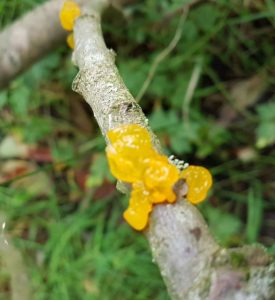
It looks as if this bright yellow blob of jelly might be living off the tiny dead branch shown here, but it is actually a parasite, living off the fungus that is living off the branch. The fungus it is living on is just visible poking out from under the yellow brain.
Alder Tongue Gall, Taphrina alni.
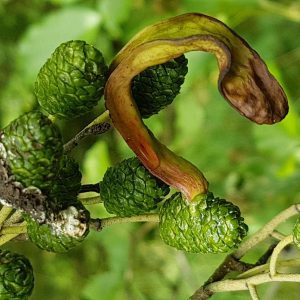
This fungus is a plant pathogen that attacks only the female catkins of the alder tree. It pushes out like a long red tongue before withering in winter.
Not a common fungus but quite common in the alder on the top field.
It doesn’t seem to harm the tree just the catkin that it has infected.
Mycorrhizal Fungi – Mutually Beneficial Partnerships with Plants
A mycorrhiza is a symbiotic association between a green plant and a fungus. The plant makes sugars and lipids by photosynthesis and gives them to the fungus, which supplies the plant with water and mineral nutrients, such as phosphorus, taken from the soil which the tree would not otherwise be able to acquire.
The Fly Agaric, Amanita muscaria
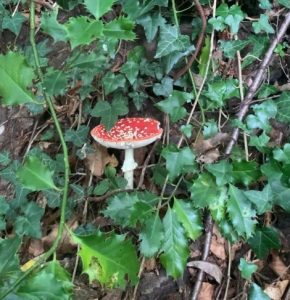
Photographer: John McCombs
This iconic mushroom looks like it has been sprinkled with breadcrumbs but is definitely not to be eaten as it is known to cause severe sickness and sometimes death.
It gets its name from a time when it was used as an insecticide as it contains ibotenic acid, known to kill insects.
As unfriendly as the Fly agaric is to humans it is totally desirable for trees and has been introduced throughout the world to live symbiotically with birch and a few other species where its underground network of mycelium brings in water and phosphorus for the tree in exchange for sugars. A desirable relationship for both.
Pantha Cap, Amanita pantherina
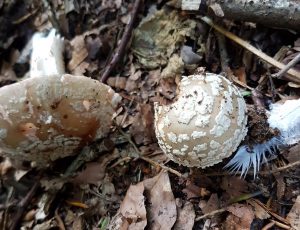
An uncommon mushroom in Childwall Woods. If you look closely you will notice the resemblance to its relative the Fly Agric described above, which has the same speckled appearance on the cap.
This tiny, shiny mushroom has a symbiotic relationship with the beech tree where it was found. The tree and the fungi are in partnership exchanging nutrients and water that the other cannot acquire on their own.
The Pantha cap is known to prefer beech trees as its partner and fits perfectly into the ecosystem of our deciduous beech woods.
The Common Earthball, Scleroderma citrinum.
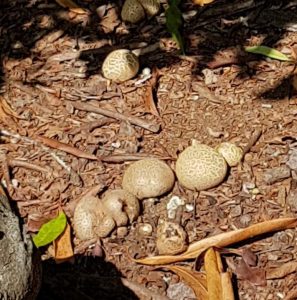
Earthballs have been very noticeable in Childwall Woods this year. These small round fungi resembling warty potatoes and can be seen growing all around the woodlands, but remember you are only seeing the fruiting body of the species. Underground the mycelium is working symbiotically with the roots of the beech tree that it is growing under.
The spores are inside the earthball and change from white to deep purple as they mature. Eventually, when fully mature, the top of the earthball cracks open and allows the wind and rain to disperse its precious content.
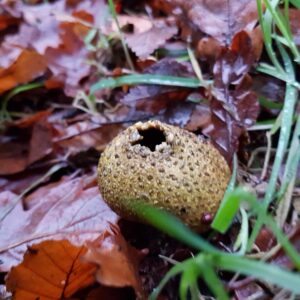
Collared Earthstar, Geastrum triplex
Collared Earthstars are similar to puffballs but the outer skin has peeled back and split to form the star shape. This pushes the centre spore-bearing sphere up to maximize dispersion.
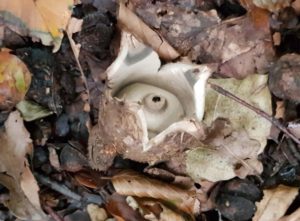
This pretty fungus likes to grow in colonies under the oaks in the woods where it helps the tree to absorb phosphorus and other elements from the soil. In return, the tree shares carbohydrates with the earth star. A perfect symbiotic relationship.
Scarlatina Bolet, Neoboletus luridformis
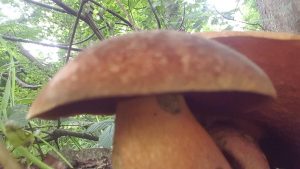
A large mushroom of the Bolet family with red pores when young and looking slightly like it has a rash on the cap. A rare sighting in Childwall Woods. These were by the Ha-ha and are in a symbiotic relationship with the beech trees nearby.
White Saddle, Helvella Crispa
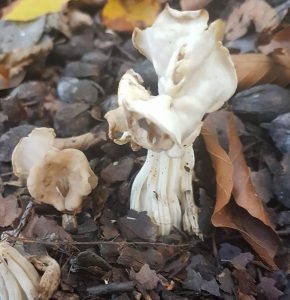
White Saddle can be found under beech trees at the end of summer where it has a mutually beneficial relationship with the tree. The mycelium from the fungi connects to the roots of the tree to bring in more water and nutrients, taking sugars and lipids that the tree produces in payment.
It prefers to be by busy paths and this one can be found under a large beech tree next to the main path through the woods.
Elfin Saddle – Helvella lacunosa.
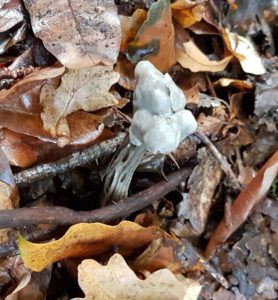
This little grey mushroom is a rarity in our woods it is Elfin Saddle – Helvella lacunosa. The ‘Lacunosa’ part of its Latin name means ‘with holes’ and the stem is visibly perforated. This little gem can be all shades of grey and is sometimes saprotrophic and sometimes mycorrhizal.
Amethyst Deceiver, Laccaria laccata
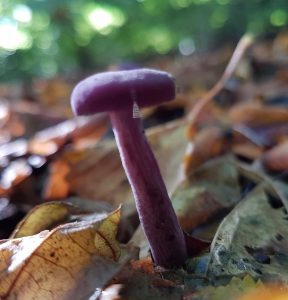
One of the jewels of the woods is the Amethyst Deceiver. So called because of its beautiful colour and because it changes shape and colour as it ages.
Tiny and well hidden in the autumn leaves but can be spotted under many of the beech trees in our woods where it has a symbiotic (mutually beneficial) relationship with the tree, sharing nutrients.
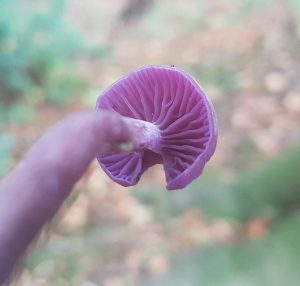
The gills
The pattern of the gills is quite distinctive. Widely spaced and the same colour as the cap.
Milkcap, (Lactarius)
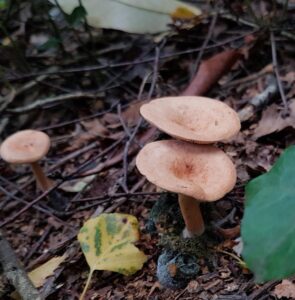
The Milkcap is so-called because of the white latex milk that comes from its gills if they are damaged.
It grows in isolation or pairs underneath oak and beech trees where it has a mutually beneficial relationship with the trees, bringing in phosphate and nitrogen in exchange for sugars.
Everything on this page has been identified as accurately as possible however with so many species existing, errors are possible.
If you like what you see on this page, why not join the Friends of Childwall Woods and Fields here?
Resources used:
Francesca Bosco and Chiara Mollea – Mycoremediation in Soil – https://www.intechopen.com/books/environmental-chemistry-and-recent-pollution-control-approaches/mycoremediation-in-soil
Jordan. M Mushroom Magic – 1989
Dickson G Green Guide Mushrooms and Toadstools of Britain and Europe. – 1996
Kew Science, – http://powo.science.kew.org/taxon/urn:lsid:indexfungorum.org:names:161267
Wikipedia .org – https://en.wikipedia.org
First Nature – https://www.first-nature.com/fungi/ganoderma-applanatum.php
First Nature – https://www.first-nature.com/fungi/xylaria-hypoxylon.php
Nature Picture Library – https://www.naturepl.com
Green Man Conservation – http://www.greenmanconservation.co.uk
Wild Food – https://www.wildfooduk.com
The Woodland Trust – https://www.woodlandtrust.org.uk
Friends of Fineshade -https://www.fineshade.org.uk
https://en.wikipedia.org/wiki/Polypore#cite_note-1
A Community for Naturalists · iNaturalist
Author: Brenda Cameron
Photographs are the author’s own unless indicated otherwise.
